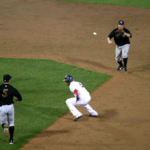The Top 7 Mistakes Baseball Players Make in the Weight Room
If you’ve been following my last few blog posts, you are aware that conditioning for baseball is very different than a traditional weight lifting program. While linear strength and overall strength are important, training the body in rotational, functional, explosive movements similar to what will be done in competition is ultimately where players will see their greatest gains.
This philosophy is tough to get across to high school and college players who often see their counterparts lifting in a more traditional manner, and whose gains may appear more visible to the naked eye.
To get your started on your weight lifting program, here are the top seven mistakes your players are probably making in the weight room:
1.) Worrying about “size”
A properly designed weight training program will contain a phase for development of muscle size (hypertrophy phase), but baseball players should not become overly concerned about gaining weight. Bigger is not always better, or stronger.
Instead, they should worry about developing strength in functional movements that can be translated to the athletic field.
Additionally, when you are working with teenagers, some of them simply are not ready to put on any significant muscle mass. Their body has not matured yet, and no amount of weight lifting is going to add a lot of visible muscle.
I began lifting weights as a freshman in high school and went from 6’0 tall 135 pounds as a sophomore to 6’1 175 pounds as a junior. I didn’t change anything significant in my routine, but my body began maturing and I was able to add muscle.
All players will mature at different ages, so if a player’s main goal is to put on weight, genetics may play a major role in not allowing them to reach their goal.
2. Afraid to lift heavy weights
Somewhere, once upon a time, someone decided that baseball players shouldn't lift heavy weights, instead they should lift light weights lots of times.
Assuming that you have developed good techniques, this could not be further from the truth. If you want to get stronger, you NEED to lift heavy weights.
Imagine trying to learn calculus by adding 2 + 2, one hundred times.
3. Training the wrong energy system:
I cringe every time I see a baseball player going on runs for several miles, or running poles in a long slow manner. Without getting overly technical, the body uses different types of energy or fuel for different intensities and length of activity.
Most baseball actions, such as swinging a bat or throwing a ball, take less than a second to perform. They are incredibly explosive and require fast rotational movements.
There is no action in baseball that require slow movement over a long period of time. Because of this, training in that manner doesn’t make much sense. In fact, long slow distance running trains the body to move slowly, not explosively.
While a solid cardiovascular base is required for all sports including baseball, that can often be developed by performing recreational activities such as basketball, soccer, or even in PE class.
Players should do explosive short sprints (under 60 yards) instead of long slow distance running, and focus on movements that allow them to generate a large amount of force in a small amount of time.
4. Misunderstanding what “core” is:
Many players and athletes think that core is the same as abdominals. It is not. Abs are good for 6-packs, core is good for performance. Also, core is more than just abdominals. A players “core” also includes their hip flexors, side obliques, and glutes.
The core of the body has two main purposes, to be a stabilizer and to be a primary mover. Most people in a gym train the core to be a primary mover (crunches, v-ups, etc), but use their core in day to day life and athletics as a stabilizer to transfer force.
A baseball player’s ultimate goal is to have a core that is stable, and rotationally explosive. In order for this to happen, players must first stabilize their core then they can begin a medball rotational power series.
This explosive movement is what will help players increase bat speed, velocity, and overall power.
5. Too many single joint movements:
Another thing you will have to train out of players is their desire to perform single joint or machine exercises. There is a reason they like doing curls, biceps, triceps, leg extensions, leg curls, and the lie. It’s because they are easy, and they feel it working a specific muscle, and they feel a burn.
In reality, very few actions on a baseball field, or any athletic field are single joint movements, so it is best to minimize them in the weight room.
I do throw my players a bone in the weight room and let them do some single joint exercises to appease them, but I view those as “extras” that they are doing, it is not the main emphasis of our program.
Train movements, not muscles
6. Using machines:
As I mentioned in the previous section on single joint movements, many athletes will hop right to single joint machines as a way to improve specific muscle groups.
The biggest problem with machines is that it, not the player, stabilizes the load through the range of motion. Players begin to lack development in stabilizer muscles, and find that weight training done by machines often doesn’t translate to the athletic field.
7. Ignoring flexibility:
I am as guilty as anyone when it comes to ignoring flexibility. I was historically inflexible, and spent little or no time working to improve my flexibility.
To me flexibility was something I did to warm-up, not something I did to enhance my performance.
With so many hitting and pitching coaches teaching hip/shoulder separation (and correctly so) it would behoove a player to have the midsection flexibility to actually perform that movement. A hitting coach can put in drill after drill, and talk about that movement all they want, but if they player isn’t flexible, they will be inherently limited in their ability to create hip shoulder separation.
Luckily, for many athletes who are as inflexible as me, flexibility is something that you can train. One of the best methods for training flexibility I have found is to do yoga. We're starting to get over the stigma that yoga is something that your mom does or something to your aunt does.
In fact we are moving so far ahead in this area that almost every professional sports team currently employs a yoga instructor.
Understand, your players will get funny looks from the football team in other teams as they're doing her yoga, however once they start seeing the benefits they won't mind those funny looks as much.
Conclusion:
Hopefully, after reading this article you'll be able to help dispel some of these myths and help your players see their results transfer from the weight room to the playing field. When creating your offseason program, make sure that your program:
1.) Has a progression in volume and intensity
2.) Includes movements that are baseball specific
3.) Avoids or minimizes the seven mistakes listed above
4.) Is flexible and can be individualized to meet the player's needs
If you're interested in learning more about a program that accomplishes those four tasks, has a periodization calendar so athletes peak at the right time, includes baseball specific movements, gives you day by day workouts, CLICK BELOW to check out our conditioning program.
 Posted by Kyle Nelson
Posted by Kyle Nelson- Posted in Conditioning
 Nov, 21, 2018
Nov, 21, 2018 3 Comments.
3 Comments.
Elite members login here
Check out what’s New/Hot!
Recognizing, Diagnosing, and Fixing Common Hitting Flaws eCourse The 3 metrics we tested on Blast motion sensors this year Sneak Peek Inside an Elite Q and A The batting practice continuum Elite Member’s area table of contents 50+ “Chaos” hitting drills
5 sample Chaos hitting drills FREE
Mental Skills and Culture Building The hitting pyramid Welcome Elite Member, Trey! Ideas for a pitcher first practice 12 week bat speed improvement plan Make plans this offseason to have your team playing their best baseball at the end of the year” Top 5 hitting drills to translate practice skill to game performanceHow we used Blast Motion sensors with a team in 2019
What to do if your hitters are overmatched Welcome Elite Member, Tommy! Setting your baserunners up for success Welcome Elite Member, Mike! A consulting call with Elite Member Matt FREE Web Clinic: Developing Athletic, Consistent, Extraordinary Infielders
 Coach Kyle Nelson
Coach Kyle Nelson





[…] is a very common misconception (see our 7 common mistakes baseball players make in the weight room post) that baseball players (specifically pitchers) need to do long slow distance […]
[…] this does not very closely mimic what happens in game play (check out our 7 mistakes your are probably making in the weight room). When using machines, the body is supported by the machines and does not need to stabilize […]
[…] are many misconceptions about weight training as it pertains to baseball (you can check out The Top 7 Mistakes Baseball Players Make in the Weight Room). But there is one more that has snuck up on me… The desire of baseball players to spend 20 […]